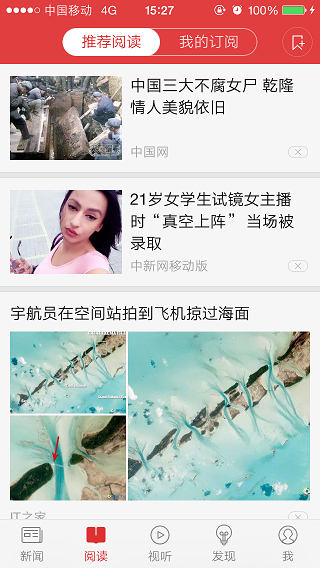一次對MKMapView的性能優化
作者:裡脊串 授權本站轉載。
前言
最近做的項目主要是LBS這塊 主打成員定位功能 我們的UI設計是這樣的
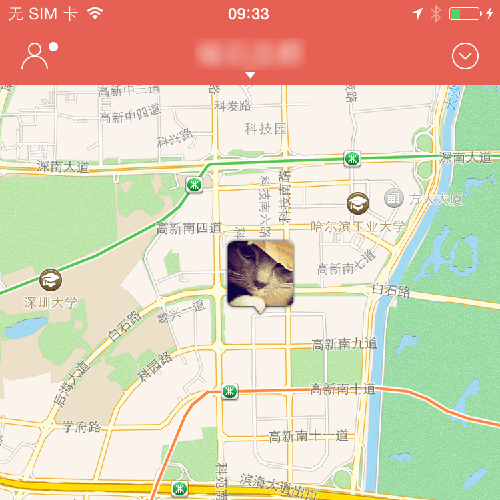
乍一看上去是挺好挺美觀的 不同的人會顯示不同的頭像 可是當人扎堆的時候 問題就來了
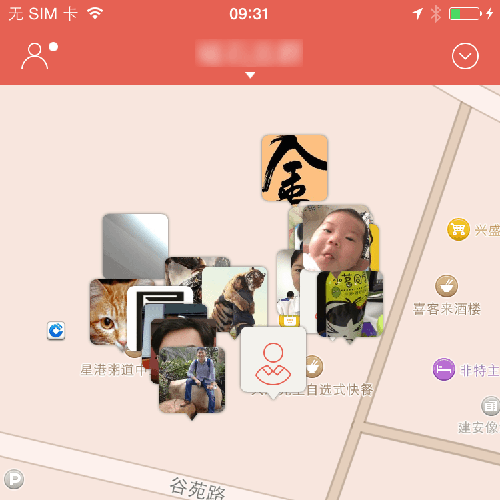
當人多的時候(例如上圖所示) 地圖滑動起來就能感覺到明顯頓卡 那種不流暢感能折磨死人 所以 自然我們要解決這個問題(等等 先不要吐槽為什麼不用地圖聚合 因為這已經是地圖放到最大了 聚合不適合這次的問題討論)
分析
首先看下我是怎麼實現這個annotationView的 由於這個annotationsView是異形的(也就是無法通過設置圓角直接得到) 而且裡面的圖片還因用戶而異 所以解決方案就是使用layer.mask來進行遮罩 代碼如下
@implementation MMAnnotationView
- (instancetype)initWithAnnotation:(id)annotation reuseIdentifier:(NSString *)reuseIdentifier
{
self = [super initWithAnnotation:annotation reuseIdentifier:reuseIdentifier];
if ( self )
{
self.frame = CGRectMake(0, 0, TRACK_ANNOTATION_SIZE.width, TRACK_ANNOTATION_SIZE.height);
self.centerOffset = CGPointMake(0, -(TRACK_ANNOTATION_SIZE.height-3)/2);
self.canShowCallout = NO;
self.avatarView = [[UIImageView alloc] initWithFrame:self.bounds];
[self addSubview:self.avatarView];
self.avatarView.contentMode = UIViewContentModeScaleAspectFill;
CAShapeLayer *shapelayer = [CAShapeLayer layer];
shapelayer.frame = self.bounds;
shapelayer.path = self.framePath.CGPath;
self.avatarView.layer.mask = shapelayer;
self.layer.shadowPath = self.framePath.CGPath;
self.layer.shadowRadius = 1.0f;
self.layer.shadowColor = [UIColor colorWithHex:0x666666FF].CGColor;
self.layer.shadowOpacity = 1.0f;
self.layer.shadowOffset = CGSizeMake(0, 0);
self.layer.masksToBounds = NO;
}
return self;
}
//mask路徑
- (UIBezierPath *)framePath
{
if ( !_framePath )
{
CGFloat arrowWidth = 14;
CGMutablePathRef path = CGPathCreateMutable();
CGRect rectangle = CGRectInset(CGRectMake(0, 0, CGRectGetWidth(self.bounds), CGRectGetWidth(self.bounds)), 3,3);
CGPoint p[3] = {
{CGRectGetMidX(self.bounds)-arrowWidth/2, CGRectGetWidth(self.bounds)-6},
{CGRectGetMidX(self.bounds)+arrowWidth/2, CGRectGetWidth(self.bounds)-6},
{CGRectGetMidX(self.bounds), CGRectGetHeight(self.bounds)-4}
};
CGPathAddRoundedRect(path, NULL, rectangle, 5, 5);
CGPathAddLines(path, NULL, p, 3);
CGPathCloseSubpath(path);
_framePath = [UIBezierPath bezierPathWithCGPath:path];
CGPathRelease(path);
}
return _framePath;
}
我用代碼生成了形狀路徑 並以此生成了layer的mask和shadowPath
使用時 只要直接用SDWebImage設置頭像就行了
[annotationView.avatarView sd_setImageWithURL:[NSURL URLWithString:avatarURL] placeholderImage:placeHolderImage];
接下來用工具分析一下問題出來哪 分析性能當然是選擇Instrments(用法在這裡就不做介紹了) 打開Core Animation 然後運行程序 滑動地圖 可以看到性能分析如下
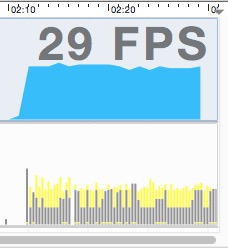
原來平均幀數只有不到30幀 這離我們的目標60幀差得實在太遠
再使用Debug Option來深入分析一下
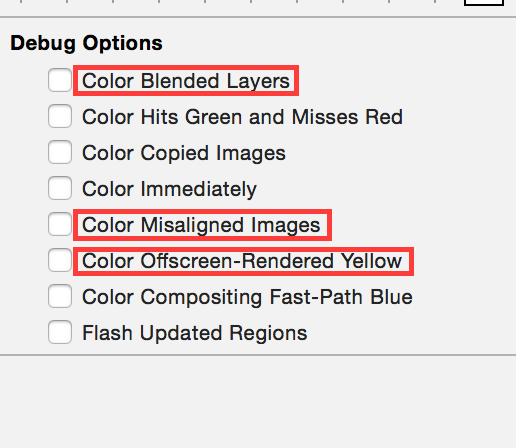
由於MKMapView的原因 這裡我們主要關心這幾個選項
- Color Blended Layers
- Color Misaligned Images
- Color Offscreen-Rendered Yellow
分別打開這幾個選項 結果如下
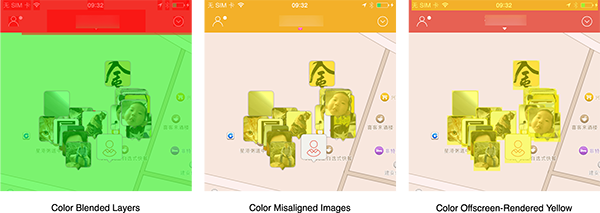
可以看到
- Color Blended Layers沒有問題 不過這也是正常的 由於使用了mask 沒有透明的地方
- Color Misaligned Images除了默認頭像外全中 這是因為服務器上的圖片大小跟顯示的大小不一致 導致縮放 而默認頭像則是一致的 所以沒問題
- Color Offscreen-Rendered Yellow全中 由於使用了mask 導致大量的離屏渲染 這也是性能下降的主要原因
解決
問題的原因找到了 那麼接下來該如何解決呢?
- 首先mask是肯定不能用了
- 其次下載下來的圖片我們要預處理成實際大小
那麼 直接把下載下來的圖片合成為我們要顯示的最終結果不就ok了嗎? 試試看
- (void)loadAnnotationImageWithURL:(NSString*)url imageView:(UIImageView*)imageView
{
//將合成後的圖片緩存起來
NSString *annoImageURL = url;
NSString *annoImageCacheURL = [annoImageURL stringByAppendingString:@"cache"];
UIImage *cacheImage = [[SDImageCache sharedImageCache] imageFromDiskCacheForKey:annoImageCacheURL];
if ( cacheImage )
{
//LLLog(@"hit cache");
imageView.image = cacheImage;
}
else
{
//LLLog(@"no cache");
[imageView sd_setImageWithURL:[NSURL URLWithString:annoImageURL]
placeholderImage:placeHolderImage
completed:^(UIImage *image, NSError *error, SDImageCacheType cacheType, NSURL *imageURL) {
if (!error)
{
UIImage *annoImage = [image annotationImage];
imageView.image = annoImage;
[[SDImageCache sharedImageCache] storeImage:annoImage forKey:annoImageCacheURL];
}
}];
}
}
@implementation UIImage (LJC)
- (UIImage*) annotationImage
{
static UIView *snapshotView = nil;
static UIImageView *imageView = nil;
if ( !snapshotView )
{
snapshotView = [UIView new];
snapshotView.frame = CGRectMake(0, 0, TRACK_ANNOTATION_SIZE.width, TRACK_ANNOTATION_SIZE.height);
imageView = [UIImageView new];
[snapshotView addSubview:imageView];
imageView.clipsToBounds = YES;
imageView.frame = snapshotView.bounds;
imageView.contentMode = UIViewContentModeScaleAspectFill;
CGFloat arrowWidth = 14;
CGMutablePathRef path = CGPathCreateMutable();
CGRect rectangle = CGRectInset(CGRectMake(0, 0, CGRectGetWidth(imageView.bounds), CGRectGetWidth(imageView.bounds)), 3,3);
CGPoint p[3] = {
{CGRectGetMidX(imageView.bounds)-arrowWidth/2, CGRectGetWidth(imageView.bounds)-6},
{CGRectGetMidX(imageView.bounds)+arrowWidth/2, CGRectGetWidth(imageView.bounds)-6},
{CGRectGetMidX(imageView.bounds), CGRectGetHeight(imageView.bounds)-4}
};
CGPathAddRoundedRect(path, NULL, rectangle, 5, 5);
CGPathAddLines(path, NULL, p, 3);
CGPathCloseSubpath(path);
CAShapeLayer *shapelayer = [CAShapeLayer layer];
shapelayer.frame = imageView.bounds;
shapelayer.path = path;
imageView.layer.mask = shapelayer;
snapshotView.layer.shadowPath = path;
snapshotView.layer.shadowRadius = 1.0f;
snapshotView.layer.shadowColor = [UIColor colorWithHex:0x666666FF].CGColor;
snapshotView.layer.shadowOpacity = 1.0f;
snapshotView.layer.shadowOffset = CGSizeMake(0, 0);
CGPathRelease(path);
}
imageView.image = self;
UIGraphicsBeginImageContextWithOptions(TRACK_ANNOTATION_SIZE, NO, 0);
[snapshotView.layer renderInContext:UIGraphicsGetCurrentContext()];
UIImage *copied = UIGraphicsGetImageFromCurrentImageContext();
UIGraphicsEndImageContext();
return copied;
}
@end
然後使用的時候 只要簡單的如下調用就OK了
[self loadAnnotationImageWithURL:avatarURL imageView:annotationView.avatarView];
看看修改之後的Instruments表現如何
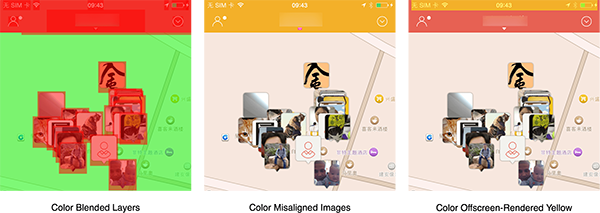
- Color Blended Layers全中 這也是無可避免的 因為顯示的就是一張帶透明度的圖 但是由於地圖的特殊性(頭像的位置變化間隔較長 所以不會經常引發合成 也沒有動畫) 所以這裡也不是問題
- Color Misaligned Images沒問題了 因為頭像已被縮放成了相同大小
- Color Offscreen-Rendered Yellow沒問題了 因為只是簡單的顯示了一張圖片 而並沒有需要離屏渲染的東西了
再來看下幀數情況
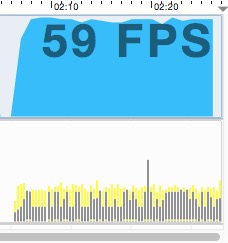
Oh-Yeah~ 不光幀數達到了我們的目標60幀(由於還有業務邏輯線程在後台跑 所以沒有那麼的穩定) 就連平均運行耗時都下降了不少 就算地圖上再多顯示幾十個人 也不成問題了
小結
不光是MKMapView 其實包括UITableView在內的很多地方都可以用文中所說的方法去優化 其核心點就是 合成+緩存 當然 由於合成還是會耗費一部分資源的 所以比較適合頭像這種小的資源
關於圖形性能優化 可以看下這篇好文(有對文中提到的Debug Option不太明白的 這裡有詳細的解釋)
- iOS工程中一天只讓停止一次的操作怎樣做?
- iOS 開發 處理UITableViewcell單選靜態改動cell文字和背景顏色的功用,且第一次默許選擇第一個cell
- iOS開發:對MKMapView的性能優化
- 教程:在iOS 10系統中一次性關閉Safari標簽
- 蘋果IOS系統一次性批量刪除多個聯系人圖文教程[多圖]
- iPhone5第一次充電多長時間為好
- 第一次怎麼給iPhone充電?
- 蘋果ios7越獄後如何完美解決一次只能安裝一次Apn
- MultiIconMover一次性移動多個App應用圖標
- iPhone5第一次充電多少時間好
- iPhone6第一次充電要充多久
- iPhone6第一次充電需要注意什麼
- iPhone6第一次充電有什麼技巧嗎?
- iPhone6怎麼樣一次性刪除電話通訊錄?
- iOS9怎麼讓你每一次應用開啟/退出都與眾不同




